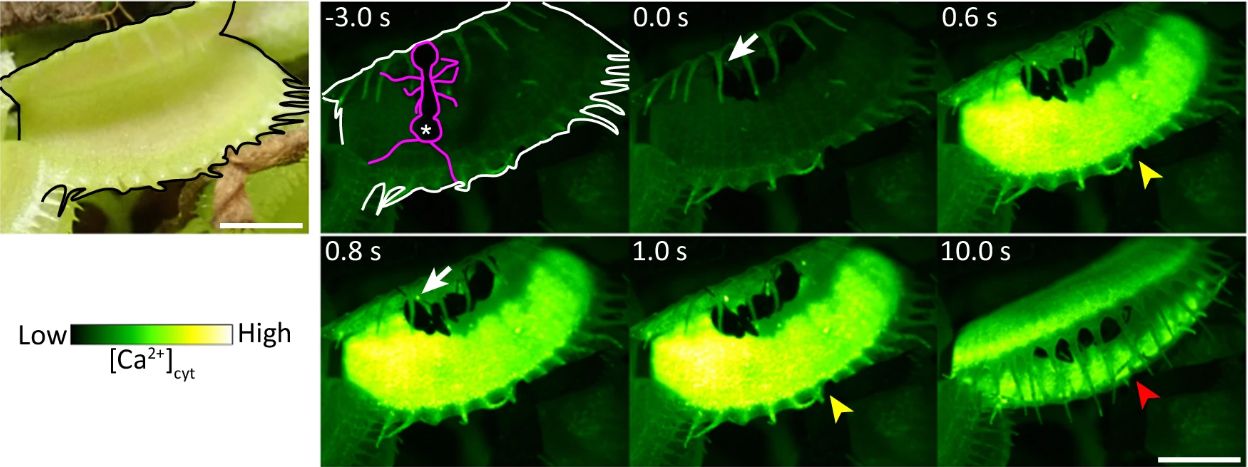Science
New Mechanosensor Revealed in Venus Flytrap’s Quick Response

Research has uncovered a crucial mechanosensor in the Venus flytrap, known as Dionaea muscipula, which explains its remarkable ability to respond quickly to prey. A study led by Hiraku Suda and colleagues, published in Nature Communications, identifies the mechanosensor DmMSL10 as central to the plant’s touch sensitivity.
The Venus flytrap and other carnivorous plants, such as the waterwheel plant (Aldrovanda vesiculosa), exhibit rapid movements to capture their prey. While species like sundews respond more slowly, the Venus flytrap can snap shut in a fraction of a second. Previous research indicated a calcium signaling mechanism, but the specific details remained unclear.
By creating a variant of the Venus flytrap that lacks the DmMSL10 channel, the researchers were able to demonstrate its significance. In both the wild-type and the knockout plants, the mechanical stimulation of the sensor hairs triggered calcium ion release. However, the knockout variant generated significantly fewer action potentials in response to stimulation.
This finding highlights that the DmMSL10 mechanosensor is essential for detecting minor movements, which allows the plant to recognize potential prey. In a subsequent experiment, ants were placed on the leaves of both plant types. The wild-type plant successfully captured the first ant, while the knockout variant displayed no response, illustrating the critical role of DmMSL10 in prey detection.
Understanding Plant Movement Mechanisms
The research provides insight into the long-range calcium signaling that enables D. muscipula to function as a highly efficient predator. This mechanism may have evolved in parallel with similar processes in animals, highlighting the intricate connections between plant and animal responses to stimuli.
With this breakthrough, scientists are now poised to explore further how such mechanisms have developed over time, potentially uncovering evolutionary links between plants and animals. The findings not only contribute to our understanding of plant biology but could also inspire innovations in biomimicry and responsive materials.
The work of Hiraku Suda and his team exemplifies the ongoing exploration of plant physiology, revealing the complexities that govern seemingly simple actions in the natural world. As research continues, the potential applications of these discoveries may extend beyond botany, influencing technology and materials science.
-

 Business5 days ago
Business5 days agoUK to Finalize Stablecoin Regulations by 2026, Boosting Crypto Sector
-

 Business5 days ago
Business5 days agoU.S. and U.K. Target Cybercriminal Networks, Seize $15 Billion
-

 Lifestyle5 days ago
Lifestyle5 days agoKISS OF LIFE’s Natty Dazzles in Micro-Shorts at Seoul Event
-

 World4 days ago
World4 days agoMilitary Artillery Plan Sparks Safety Concerns Along California Highway
-

 World5 days ago
World5 days agoTrump Signals Reluctance to Sell Tomahawk Missiles to Ukraine
-

 Business5 days ago
Business5 days agoCalifornia to Eliminate All Plastic Bags from Stores by 2026
-

 Sports5 days ago
Sports5 days agoDomenico Doran’s Stellar Performance Leads Bishop Amat to Victory
-

 Entertainment5 days ago
Entertainment5 days agoLouisiana Senate Raises Concerns Over Medicaid Cuts Amid New Bill
-

 Entertainment5 days ago
Entertainment5 days agoUtah Communities Rally as Government Shutdown Strains Resources
-

 Sports5 days ago
Sports5 days agoTrade Low, Trade High: Key NHL Players to Consider Now
-

 Science2 days ago
Science2 days agoAncient Dinosaur Discovery in Argentina Reveals Evolutionary Insights
-

 Health2 days ago
Health2 days agoUncovering the Hidden Link Between Knee Pain and Hip Issues









